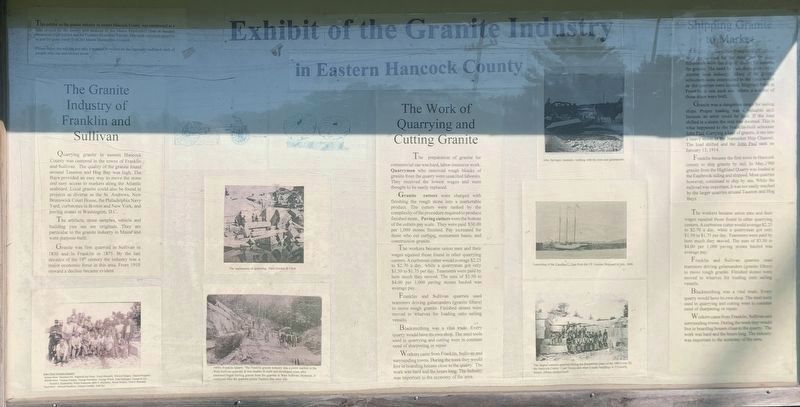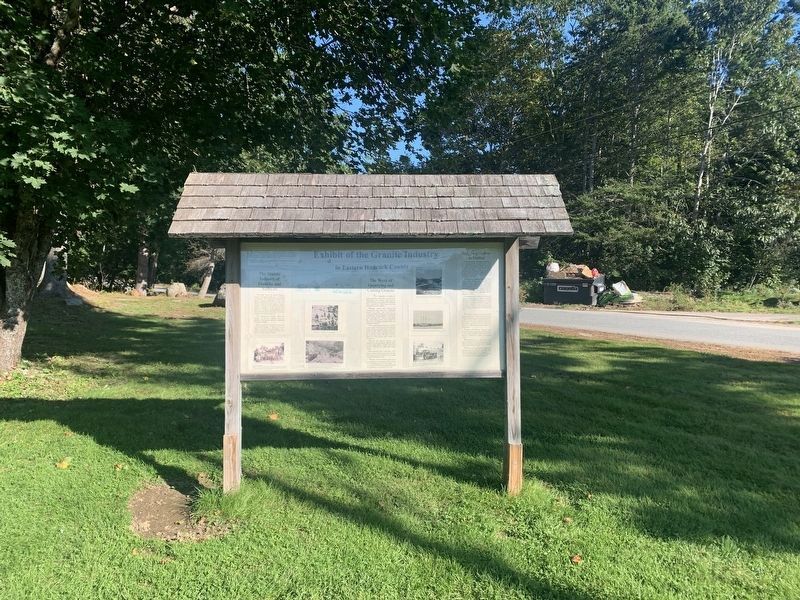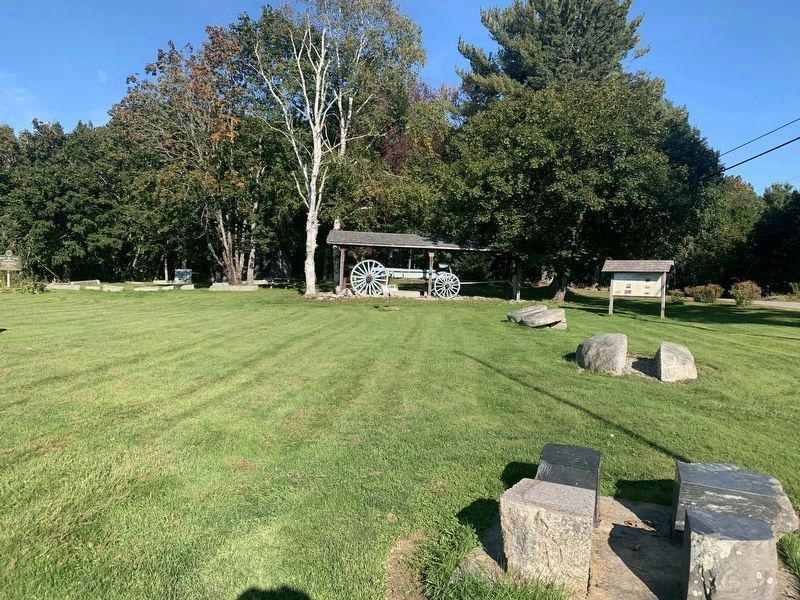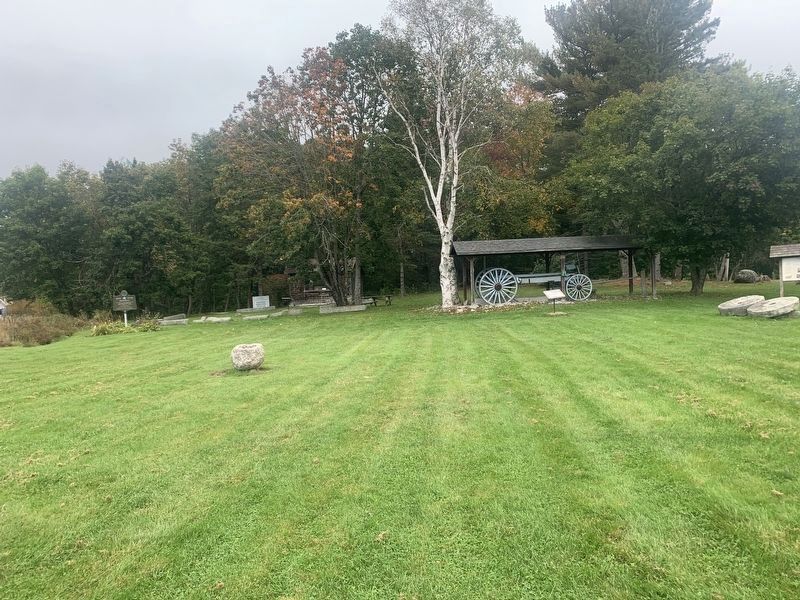Franklin in Hancock County, Maine — The American Northeast (New England)
Exhibit of the Granite Industry
In Eastern Hancock County
The Granite Industry of Franklin and Sullivan
Quarrying granite in eastern Hancock County was centered in the towns of Franklin and Sullivan. The quality of granite found around Tranton and Hog Bay was high. The Bays provided an easy way to move the stone and easy access to markets along the Atlantic seaboard. Local granite could also be found in projects as diverse as St. Andrews, New Brunswick Court House, the Philadelphia Navy Yard, curbstones in Boston and New York, and paving stones in Washington D.C.
The artifacts, stone samples, vehicle and building you see are the originals. They are particular to the granite industry in Maine and were purpose-built.
Granite was first quarried in Sullivan in 1830 and in Franklin in 1875. By the last decades of the 19th century the industry was a major economic force in the area. From 1910 onward a decline became evident.
The Work of Quarrying and Cutting Granite
The preparation of granite for commercial use is hard, labor-intensive work. Quarrymen who removed the rough blocks of granite from the quarry were unskilled labor. They received the lowest pay and thought to be easily replaceable.
Granite cutters were charged with finishing the rough stone into a marketable product. The cutters were ranked by the complexity of the procedure required to produce finished stone. Paving cutters were the bottom of the cutters pay scale. They were paid $30.00 per 1,000 stones finished. Pay increased for those who cut curbing , monument bases, and construction granite.
The workers became union men and their wages equaled those found in other quarrying centers. A curbstone cutter would average $2.25 to $2.70 a day, while a quarryman got only $1.50 to $1.75 per day. Teamsters were paid by how much they moved. The sum of $3.50 to $4.00 per 1,000 paving stones hauled was average pay.
Franklin and Sullivan quarries used teamsters driving galamanders (granite lifters) to move rough granite. Finished stones were moved to wharves for loading onto sailing vessels.
Blacksmithing was a vital trade. Every quarry would have its own shop. The steel tools used in quarrying and cutting were in constant need of sharpening or repair.
Workers came from Franklin, Sullivan and the surrounding towns. During the week they would live in boarding houses close to the quarry. The work was hard and the hours long. The industry was important to the economy of the area.
Shipping Granite to Market
Granite products from Franklin and Sullivan were transport for the most part by ship. Schooners were the ship of choice for moving granite. The need for such ships gave rise to another local industry. Many of the granite schooners were constructed in the same towns as the quarries were located. Shipyard Point in Franklin is one such site where a number of these ships was built.
Granite was a dangerous cargo for sailing ships. Proper loading was a valuable skill because an error could be fatal. If the load shifted in a storm the ship was doomed. This is what happened to Franklin-built schooner John Paul. Carrying a load of granite, it ran into a heavy storm in the Nantucket Ship Channel. The load shifted and the John Paul sank on January 13, 1914.
Franklin became the first town in Hancock county to ship granite by rail. In May 1900, granite from the Highland Quarry was loaded at Eastbrook siding and shipped. Most quarries, however, continued to ship by sea. While the railroad was important, it was not easily reached by the larger quarries around Taunton and Hog Bays.
The workers became union men and their wages equaled those found in other quarrying centers. A curbstone cutter would average $2.25 to $2.70 a day, while a quarryman got only $1.50 to $1.75 per day. Teamsters were paid by how much they moved. The sum of $3.50 to $4.00 per 1,000 paving stones hauled was average pay.
Blacksmithing was a vital trade. Every quarry would have its own shop. The steel tools used in quarrying and cutting were in constant need of sharpening or repair.
Workers came from Franklin, Sullivan and the surrounding towns. During the week they would live in boarding houses close to the quarry. The work was hard and the hours long. The industry was important to the economy of the area.
Erected by Franklin Historical Society, Maine Experience class - Sumner Memorial H.S.
Topics. This historical marker is listed in this topic list: Industry & Commerce. A significant historical year for this entry is 1830.
Location. 44° 34.729′ N, 68° 15.836′ W. Marker is in Franklin, Maine, in Hancock County. Marker is at the intersection of West Franklin Road (Maine Route 182) and Grist Mill Road, on the right when traveling north on West Franklin Road. Touch for map. Marker is at or near this postal address: 105 West Franklin Road, Franklin ME 04634, United States of America. Touch for directions.
Other nearby markers. At least 8 other markers are within 4 miles of this marker, measured as the crow flies. Galamander (a few steps from this marker); Curbstone Exhibit (within shouting distance of this marker); Franklin Revolutionary War Memorial (within shouting distance of this marker); Civil War Memorial (approx. 1.8 miles away); World War Memorial (approx. 1.8 miles away); Old Town Hall Site (approx. 1.8 miles away); Franklin Veterans Memorial (approx. 1.8 miles away); Defenders of the Union (approx. 3˝ miles away). Touch for a list and map of all markers in Franklin.
Credits. This page was last revised on November 5, 2023. It was originally submitted on October 16, 2023, by Steve Stoessel of Niskayuna, New York. This page has been viewed 54 times since then and 19 times this year. Photos: 1, 2, 3, 4. submitted on October 16, 2023, by Steve Stoessel of Niskayuna, New York. • Michael Herrick was the editor who published this page.



